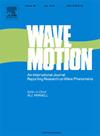Low-frequency sub-Bragg phenomena in multilayered vibroacoustic metamaterials
IF 2.5
3区 物理与天体物理
Q2 ACOUSTICS
引用次数: 0
Abstract
Beyond classical Bragg diffraction, we report on new sub-Bragg phenomena to achieve broadband low-frequency sound manipulation at the sub-wavelength scale in a multilayered vibroacoustic metamaterial. Remarkably, we unveil the formation of genuinely sub-wavelength Bragg-like band-splitting induced bandgaps, generalizing the "band-folding induced bandgaps" in the literature. Additionally, we propose a methodology to widen sub-wavelength local resonance bandgaps by hosting two local resonances within the same bandgap. These sub-Bragg phenomena are realized at low frequencies in an axisymmetric vibroacoustic metamaterial consisting of repetitive multilayered unit cells, each composed of two layers of membrane-cavity resonators. The coupled sound-structure interaction is solved exactly. The studied system exhibits sub-wavelength acoustical transparency, akin to “electromagnetically induced transparency”, and an acoustic analogue of "plasma oscillations". We derive canonical conditions for the emergence of band-splitting bandgaps, showing they are exclusive to multilayered configurations. These band-splitting bandgaps resemble Bragg bandgaps in their attenuation, band-crossing capabilities, and potential to host topological interface states. We also reveal that classical geometric Bragg diffraction does not apply to the periodic multilayered vibroacoustic configurations examined. The studied sub-wavelength phenomena unlock new possibilities for controlling low-frequency wave propagation in the sub-Bragg regime. Design guidelines for maximizing bandgap width within the low-frequency regime are provided, and the attenuation performance across different bandgaps is demonstrated through numerical simulations. We anticipate that our findings, while demonstrated here in vibroacoustic metamaterials, provide a promising approach for advanced acoustic devices, and could inspire future work exploring similar sub-wavelength mechanisms in other classes of physical systems.
多层振动声学超材料中的低频亚bragg现象
除了经典的布拉格衍射之外,我们报道了在多层振动声学超材料中实现亚波长尺度宽带低频声音操纵的新亚布拉格现象。值得注意的是,我们揭示了真正的亚波长类布拉格带分裂诱导带隙的形成,推广了文献中的“带折叠诱导带隙”。此外,我们提出了一种方法,以扩大亚波长局域共振带隙通过承载两个局域共振在同一带隙。这些亚布拉格现象是在轴对称振动声学超材料中实现的,该材料由重复的多层单元胞组成,每个单元胞由两层膜腔谐振器组成。得到了声-结构耦合作用的精确解。所研究的系统表现出亚波长的声学透明,类似于“电磁感应透明”,以及“等离子体振荡”的声学模拟。我们推导了带裂带隙出现的典型条件,表明它们是多层结构所独有的。这些带分裂带隙在衰减、带穿越能力和承载拓扑界面状态的潜力方面类似于Bragg带隙。我们还揭示了经典的几何布拉格衍射并不适用于周期性多层振动声结构。所研究的亚波长现象为控制亚布拉格区低频波传播打开了新的可能性。提供了在低频范围内最大化带隙宽度的设计准则,并通过数值模拟证明了不同带隙的衰减性能。我们预计,我们的发现,虽然在振动声学超材料中得到了证明,但为先进的声学设备提供了一种有前途的方法,并可能激发未来在其他物理系统中探索类似亚波长机制的工作。
本文章由计算机程序翻译,如有差异,请以英文原文为准。
求助全文
约1分钟内获得全文
求助全文
来源期刊

Wave Motion
物理-力学
CiteScore
4.10
自引率
8.30%
发文量
118
审稿时长
3 months
期刊介绍:
Wave Motion is devoted to the cross fertilization of ideas, and to stimulating interaction between workers in various research areas in which wave propagation phenomena play a dominant role. The description and analysis of wave propagation phenomena provides a unifying thread connecting diverse areas of engineering and the physical sciences such as acoustics, optics, geophysics, seismology, electromagnetic theory, solid and fluid mechanics.
The journal publishes papers on analytical, numerical and experimental methods. Papers that address fundamentally new topics in wave phenomena or develop wave propagation methods for solving direct and inverse problems are of interest to the journal.
 求助内容:
求助内容: 应助结果提醒方式:
应助结果提醒方式:


